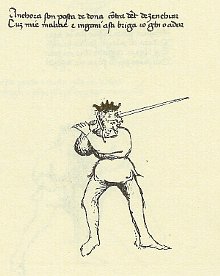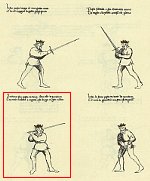| Fiore dei Liberi: Flos Duellatorum, 1410 (Pisani-Dossi, F. Novati, Bergamo, 1902) |
| 4 spada longa - longsword |
4.1.7 posta de dona la sinestra  , pulsativa1 (guard of the woman on the left) , pulsativa1 (guard of the woman on the left) |


Anchora son posta de dona contra dent de zenchiar
Cum mie malicie e ingani asa' briga io ghi ò a dar |
I am the guard of the woman and also counter to the boar's tooth
With my malice and cunning I and sword will start a brawl |
Synopsis: Fiore clearly indicates that the posta de dona is counter to the dent de zenchiar and is the only case in which he explicitly states that the pair of guards represents counters to the other. The phrase of course is re-ordered slightly in order to achieve a rhyming couplet hence, introduces possible interpretation errors, however, the translation of the first line of the couplet is considered fairly accurate. The second line of the couplet implies that the guard of the woman is a good position from which to deliver strikes to the zugadore, and that it may be an advantage in a "brawl" in which repeated strikes and defense would be required.
Practical Application: This posta is one of the most versatile guards, able to defend against cuts and thrusts, and which can also deliver cuts and thrusts. It is also the most natural position to take when wielding the sword, and therefore, the quickest guard to return to and then to release another strike. The posta de dona also is able to deliver the most powerful strikes, but can also deliver unexpected results such as the "villain strike" described earlier in this treatise.
Footnotes
- pulsativa refers to where one must deliver a counter attack (cut or thrust) as a cover in order to survive an attack concurrently while taking a step. This info was derived from the Getty's version of Liberi's treatise.
 , pulsativa1 (guard of the woman on the left)
, pulsativa1 (guard of the woman on the left) , pulsativa1 (guard of the woman on the left)
, pulsativa1 (guard of the woman on the left)